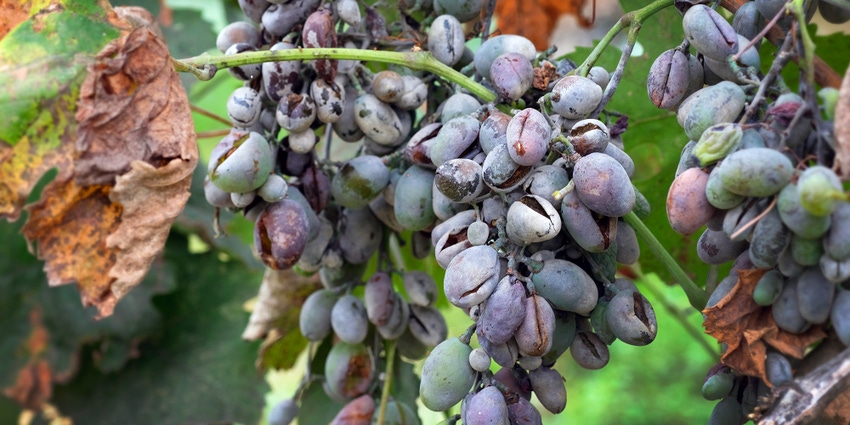March 11, 2020

Sponsored Content
We’ve all heard the saying “The best defense is a good offense.” Nowhere is this truer than where powdery mildew is concerned. Controlling disease in vineyards can be tricky, but the most effective way to avoid harmful fungi from taking over is to get an early start and keep up a strong regimen all season long.
Chances are, if you had a powdery mildew problem in 2019, your vines are at greater risk for this widespread fungal disease in 2020. Powdery mildew can overwinter in grapes and cause serious problems as early as the bud-break stage and before symptoms are visible. The amount of overwintering inoculum matters when it comes to powdery mildew infections, so it’s critical to have a well-designed preventative program, especially when going into a potentially high-pressure year.
Developing an effective preventative protocol
Experience has proven that a preventative program provides the best control for powdery mildew. Good early-season control not only helps prevent mildew establishment but reduces the risk for mildew epidemics later. To protect vineyards from overwintering powdery mildew, start fungicide sprays early — but not before vines start producing new growth — and repeat sprays at appropriate intervals.
Your spray program should continue throughout the entire season to ensure control and prevent outbreaks. But consistency and frequency aren’t the only factors in protecting against powdery mildew — you also need to alternate fungicides in order to avoid resistance development. Use products with differing modes of action to manage resistance and ensure an effective spray regimen.
Finally, your program should include fungicides that are easily mixable. Sprays are ineffective if they’re not applied with proper coverage, so choose products that mix quickly and remain dissolved for even application.
UPL offers a variety of fungicides for grapes to provide growers with the protection they need against powdery mildew and keep their vineyard healthy all season long, including CUPROFIX® ULTRA DISPERSS®, ELEVATE®, MANZATE® PRO-STICK™, MICROTHIOL® DISPERSS, PH-D® and PROCURE®, along with TOPSIN® WSB for Eutypa dieback.
CUPROFIX ULTRA DISPERSS Fungicide (FRAC class M1) is a fixed copper sulfate option for control of powdery mildew and Phomopsis. Its unique DISPERSS formulation easily and completely mixes in the tank, allowing for more consistent and greater surface contact. For broad-spectrum control, CUPROFIX ULTRA DISPERSS can be conveniently tank-mixed with other labeled fungicides.
ELEVATE Fungicide (FRAC group 17) provides locally systemic activity and is excellent at controlling Botrytis bunch rot and powdery mildew. ELEVATE can provide post-infection activity when applied early in the disease life cycle and has been shown to enhance the efficacy of other fungicides when used in a powdery mildew spray program. With a zero-day pre-harvest interval, you can use ELEVATE up to the day of harvest.
MANZATE PRO-STICK Fungicide (FRAC class M3) provides advanced formulation technology in the fight against key diseases such as dead arm and downy mildew. A market-leading, multi-site, protectant fungicide, MANZATE PRO-STICK has effectively been used for decades without a reported incidence of resistance, making it a standard in almost any disease management program.
MICROTHIOL DISPERSS Fungicide (FRAC group M2) combines sulfur and science to deliver excellent efficacy in a superior formulation for powdery mildew. MICROTHIOL DISPERSS also provides the added benefit of mite control. A patented micronized formulation process ensures a more consistent spray coverage and greater surface contact than other sulfur products.
PH-D Fungicide (FRAC group 19) is a broad-spectrum fungicide that offers a high degree of powdery mildew and Botrytis control in grapes. Its benefit of a zero-day pre-harvest interval and 4-hour REI makes it an excellent option for disease management sprays close to harvest. PH-D is the only product in FRAC group 19, making it an important resistance management tool.
PROCURE Fungicide (FRAC group 3) is rated as one of the highest for powdery mildew control. PROCURE has both protective and curative efficacies in controlling diseases, as well as systemic activity in the plant. When applied in a powdery mildew spray schedule, PROCURE will enhance the activity of registered fungicides used for Botrytis bunch rot control. It’s also available under brand name TRIONIC Fungicide in a larger pack size.
If Eutypa dieback is your disease concern, TOPSIN WSB (FRAC group 1) is your go-to brand. TOPSIN is a systemic fungicide that moves from top to bottom, and upward and outward within the leaves and stem. It is recommended TOPSIN be rotated with fungicides in different FRAC groups. Use of TOPSIN WSB for Eutypa dieback is approved for use under specific state local need labels.
For more information on how to combat disease in your vineyard this season, contact your local UPL sales representative or visit www.upl-ltd.com/us.
Always read and follow label directions. UPL, the UPL logo, OpenAg and all products are trademarks of a UPL Corporation Limited Group Company. ©2020 UPL Corporation Limited Group Company. SPC-2013B
You May Also Like




